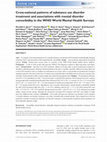Papers by Victor Makanjuola
Drug and Alcohol Dependence
Neuropsychiatric Disease and Treatment, 2017
Introduction: Bipolar disorder (BD) remains both a clinical and public health challenge worldwide... more Introduction: Bipolar disorder (BD) remains both a clinical and public health challenge worldwide, especially in developing countries such as Nigeria. Many studies have focused on prevalence and recurrences among BD service seekers but little has been documented on the nature, strength, direction, existence, and estimation of association between times to recurrence of the two possible polarities or mood episodes in BD. In this study, we explored the association between durations before recurrence of depression and manic episodes among people seeking treatment for BD. Methods: This analytical study used retrospective data of 467 persons who sought treatment for BD at the psychiatric clinic of

African journal of medicine and medical sciences
BACKGROUND Inappropriate arginine vasopressin (AVP) secretion has been reported in schizophrenic ... more BACKGROUND Inappropriate arginine vasopressin (AVP) secretion has been reported in schizophrenic patients. However, there is lack of information on serum level of copeptin and its diagnostic performance in schizophrenia. This study therefore, evaluated serum copeptin and its diagnostic performance in schizophrenic patients. METHODS Sixty subjects (30.02 ± 7.17 years) with schizophrenia (19 drug naïve [DNS] and 41 schizophrenics on treatment [SOT]) and 30 healthy individuals (33.62 ± 9.05 years) with no history of schizophrenia were enrolled into this study. Schizophrenia was diagnosed using the Tenth edition of the International Classification of Diseases and Related Health Problems (ICD-10). Estimation of serum copeptin, plasma electrolytes (potassium, sodium and chloride) and uric acid was done using ELISA, Ion-Selective electrode (ISE) and enzymatic method respectively. RESULTS Copeptin was significantly higher while uric acid, potassium and sodium levels were significantly lower in patients with schizophrenia compared with controls. Similarly, copeptin was significantly higher while sodium, potassium and uric acid levels were significantly lower in DNS and SOT compared with controls. However, insignificant elevation in copeptin level and insignificant reduction in sodium, potassium, chloride and uric acid levels were observed in DNS compared with SOT. The Area under the curve (AUROC) for copeptin was 0.686 (P = 0.004). CONCLUSION There is elevated copeptin level in patients with schizophrenia and that copeptin levels might be a valuable tool in the diagnosis of schizophrenia.

Nigerian journal of medicine : journal of the National Association of Resident Doctors of Nigeria
In a developing country like Nigeria where prohibitive cost and availability limits the use of at... more In a developing country like Nigeria where prohibitive cost and availability limits the use of atypical antipsychotics, a large number of patients on antipsychotics are expected to be on conventional antipsychotics. Studies have shown that more than half of patients on conventional antipsychotics are also prescribed anti-cholinergic drugs. There are reports that psychiatric patients may not know important aspects of their treatments. Such audits of psychiatric services are uncommon in Nigeria. Socio-demographic data and views about the specific role of Benzhexol in treatment were obtained from all patients whose case records showed that they were concurrently prescribed Benzhexol alongside antipsychotics. 200 participants met inclusion criteria. A third (n = 60; 30%) reported not knowing the role of Benzhexol in their treatment as against 70% (n = 140) who claimed to know. Of those who claimed to know, 64% (n = 89) gave responses that reflected no understanding. Majority (n = 66; 74...

African journal of medicine and medical sciences, 2009
Frontotemporal lobal degeneration (FTLD) is a clinically heterogeneous group of sporadic and fami... more Frontotemporal lobal degeneration (FTLD) is a clinically heterogeneous group of sporadic and familial neurodegenerative diseases characterized by dementia, alteration in language and/or behaviour, loss of executive skills and sometimes Parkinsonian features resulting from degeneration predominantly affecting the anterior frontal and temporal regions of the brain. Three main clinical subtypes including frontotemporal dementia (FTD), semantic dementia (SD) and progressive non-fluent aphasia (PNFA) have been described depending on the clinical phenomenology, the areas of the brain where the disorder begins and where the most extensive degeneration occurs. We describe a case of frontotemporal dementia in a 58 year old Nigerian woman and also review the current literature. Recent genetic studies have expanded the frontiers of knowledge about FTD while the search for appropriate drug treatments continues.

European Psychiatry, 2010
Objectives To determine how informed psychiatric outpatients are about the role of anticholinergi... more Objectives To determine how informed psychiatric outpatients are about the role of anticholinergic drugs in their treatment. Methods Using a clinician-administered questionnaire designed by the authors; socio-demographic data and views about the role of Benzhexol in their treatments were obtained from all patients whose case records showed that they were currently prescribed Benzhexol. Results 98 patients met inclusion criteria, mostly males (n=54; 55.1%). The respondents were predominantly in the age range 25 - 44years (n=67; 68.4%) and single (n=52; 53%). Two-thirds had no more than secondary education. Though more than half of respondents reported having being on their current combination of drugs for more than 1 year, 34% could not give the names of any of their medications. A third reported not knowing the role of Benzhexol in their treatment and of those who claimed to know, 64% (n=42) gave responses that reflected no understanding. Majority (n=31; 74%) of such responses were adjudged to have potentially deleterious implications on their health and outcome. There was no statistically significant association between educational status and knowledge of the role of Benzhexol in patients’ treatment. Only 18% reported ever being educated about the role of Benzhexol in their treatment. Conclusion The study provides evidence that majority of the patients may not be well informed about important aspects of their treatment and that health workers may have neglected to educate them. It further calls for an urgent need to improve the patient-information aspects of service delivery in our clinics.

British Journal of Psychiatry, 2010
BackgroundAdverse childhood experiences have been associated with a variety of mental health prob... more BackgroundAdverse childhood experiences have been associated with a variety of mental health problems in adult life.AimsTo examine whether this reported link between childhood experiences and mental health disorders in adult life applies in a Sub-Saharan African setting where cultural and family attributes may be different.MethodA multistage random sampling was used in the Nigerian Survey of Mental Health and Well-Being (NSMHW) to select respondents for face-to-face interviews. Assessments of family-related adverse childhood experiences and lifetime mental health disorders were conducted with the Composite International Diagnostic Interview (CIDI 3.0).ResultsAlmost half of the respondents had experienced an adverse childhood experience within the context of the family before they were 16 years of age. Associations between adverse childhood experiences and adult mental health disorders were few and were attenuated when clustering of adverse childhood experience and disorder comorbidi...
Substance Use & Misuse, 2010
The study aims to estimate the prevalence and predictors of not following the gateway theory. Res... more The study aims to estimate the prevalence and predictors of not following the gateway theory. Respondents were selected from a multistage stratified clustered sampling of households in five of Nigeria's six geopolitical regions. Interviews were conducted between February 2002 and May 2003 using the CIDI-version.3 with a total sample size (N) of 2,143. Cumulative incidence proportions of not following a gateway pattern were estimated with SUDAAN. Predictors of this were estimated using multivariate logistic regression models. The deviation from the normative sequence of drug use occurs albeit infrequently. The public health implications of this are discussed as well as the limitations of the findings.
International Psychiatry, 2014
This study compared beliefs about and attitudes to mental illness among medical and nursing stude... more This study compared beliefs about and attitudes to mental illness among medical and nursing students at two teaching hospitals in Nigeria with very different levels of psychiatric instructional capacity. Factor analysis of responses to a 43-item self-report questionnaire identified three domains: social acceptance of people with mental illness; belief in non-superstitious causation of mental illness; and stress, trauma and poverty as external causes of mental illness, with entitlement to employment rights. Students at the hospital with a larger, functioning psychiatry department had significantly higher scores on all three factors. Culturally enshrined beliefs and attitudes about mental illness are not uncommon among medical trainees. The availability of psychiatric education and services may have a positive effect on beliefs and attitudes.
International Psychiatry, 2014
This study compared beliefs about and attitudes to mental illness among medical and nursing stude... more This study compared beliefs about and attitudes to mental illness among medical and nursing students at two teaching hospitals in Nigeria with very different levels of psychiatric instructional capacity. Factor analysis of responses to a 43-item self-report questionnaire identified three domains: social acceptance of people with mental illness; belief in non-superstitious causation of mental illness; and stress, trauma and poverty as external causes of mental illness, with entitlement to employment rights. Students at the hospital with a larger, functioning psychiatry department had significantly higher scores on all three factors. Culturally enshrined beliefs and attitudes about mental illness are not uncommon among medical trainees. The availability of psychiatric education and services may have a positive effect on beliefs and attitudes.
International Journal of Drug Policy, 2019
Background: Illicit drug use and associated disease burden are estimated to have increased over t... more Background: Illicit drug use and associated disease burden are estimated to have increased over the past few decades, but large gaps remain in our knowledge of the extent of use of these drugs, Degenhardt et al.

Traditional and complementary systems of medicine include a broad range of practices, which are c... more Traditional and complementary systems of medicine include a broad range of practices, which are commonly embedded in cultural milieus and refl ect community beliefs, experiences, religion, and spirituality. Two major components of this system are discernible: complementary alternative medicine and traditional medicine, with diff erent clientele and correlates of patronage. Evidence from around the world suggests that a traditional or complementary system of medicine is commonly used by a large number of people with mental illness. Practitioners of traditional medicine in low-income and middle-income countries fi ll a major gap in mental health service delivery. Although some overlap exists in the diagnostic approaches of traditional and complementary systems of medicine and conventional biomedicine, some major diff erences exist, largely in the understanding of the nature and cause of mental disorders. Treatments used by providers of traditional and complementary systems of medicine...

Drug and Alcohol Dependence, 2021
AIM We examined prevalence and factors associated with receiving perceived helpful alcohol use di... more AIM We examined prevalence and factors associated with receiving perceived helpful alcohol use disorder (AUD) treatment, and persistence in help-seeking after earlier unhelpful treatment. METHODS Data came from 27 community epidemiologic surveys of adults in 24 countries using the World Health Organization World Mental Health surveys (n = 93,843). Participants with a lifetime history of treated AUD were asked if they ever received helpful AUD treatment, and how many professionals they had talked to up to and including the first time they received helpful treatment (or how many ever, if they had not received helpful treatment). RESULTS 11.8% of respondents with lifetime AUD reported ever obtaining treatment (n = 9378); of these, 44% reported that treatment was helpful. The probability of obtaining helpful treatment from the first professional seen was 21.8%; the conditional probability of subsequent professionals being helpful after earlier unhelpful treatment tended to decrease as more professionals were seen. The cumulative probability of receiving helpful treatment at least once increased from 21.8% after the first professional to 79.7% after the seventh professional seen, following earlier unhelpful treatment. However, the cumulative probability of persisting with up to seven professionals in the face of prior treatments being unhelpful was only 13.2%. CONCLUSION Fewer than half of people with AUDs who sought treatment found treatment helpful; the most important factor was persistence in seeking further treatment if a previous professional had not helped. Future research should examine how to increase the likelihood that AUD treatment is found to be helpful on any given contact.

Spirituality and Mental Health Across Cultures, 2021
Traditional African religions are diverse with each having its own rituals and symbolisms and oft... more Traditional African religions are diverse with each having its own rituals and symbolisms and often defining an ethnic and language group. Even though most subscribe to the notion of a supreme deity, a common feature of these religions is their polythetic philosophy in which there are many layers of deities and ancestral spirits. The African gods are not jealous, making religious fundamentalism alien to the adherents of traditional religions. African traditional healing practices, rooted in African religious beliefs, are commonly sought because they are thought to get at the root causes of illness and not just to provide relief from symptoms. In the face of globalization as well as pervasive influence of Western cultures, the Abrahamic religions of Christianity and Islam now jostle for dominance and for the sole occupation of the spiritual space. However, even when the average African subscribes to an Abrahamic faith, it is common for them to retain a world view steeped in tradition...
The Lancet, 2020
, and after a signed data access agreement with the principal investigator. Author Contributions ... more , and after a signed data access agreement with the principal investigator. Author Contributions OG drafted the paper with input from RA, DC, and SS. OG, JA, CO, and SS obtained funding. All authors reviewed the draft and approved the final version. OG designed the trial with inputs from JA, CO, LP, and SS; OG, with input from VM, designed the intervention and both delivered the intervention training and were responsible for the assessment tools; OG, JA and LK supervised trial conduct; TB and OE designed and managed the database and TB conducted the statistical analyses; DC and TB conducted the economic analysis. (LP was a scientific collaborator and was involved in study design as permitted under the funding collaborative agreement).

Addiction, 2019
Aims To examine cross-national patterns of 12-month substance use disorder (SUD) treatment and mi... more Aims To examine cross-national patterns of 12-month substance use disorder (SUD) treatment and minimally adequate treatment (MAT), and associations with mental disorder comorbidity. Design Cross-sectional, representative household surveys. Setting Twenty-seven surveys from 25 countries of the WHO World Mental Health Survey Initiative. Participants A total of 2446 people with past-year DSM-IV SUD diagnoses (alcohol or illicit drug abuse and dependence). Measurements Outcomes were SUD treatment, defined as having either received professional treatment or attended a self-help group for substance-related problems in the past 12 months, and MAT, defined as having either four or more SUD treatment visits to a health-care professional, six or more visits to a non-health-care professional or being in ongoing treatment at the time of interview. Covariates were mental disorder comorbidity and several socioeconomic characteristics. Pooled estimates reflect country sample sizes rather than population sizes. Findings Of respondents with pastyear SUD, 11.0% [standard error (SE) = 0.8] received past 12-month SUD treatment. SUD treatment was more common among people with comorbid mental disorders than with pure SUDs (18.1%, SE = 1.6 versus 6.8%, SE = 0.7), as was MAT (84.0%, SE = 2.5 versus 68.3%, SE = 3.8) and treatment by health-care professionals (88.9%, SE = 1.9 versus 78.8%, SE = 3.0) among treated SUD cases. Adjusting for socioeconomic characteristics, mental disorder comorbidity doubled the odds of SUD treatment [odds ratio (OR) = 2.34; 95% confidence interval (CI) = 1.71-3.20], MAT among SUD cases (OR = 2.75; 95% CI = 1.90-3.97) and MAT among treated cases (OR = 2.48; 95% CI = 1.23-5.02). Patterns were similar within country income groups, although the proportions receiving SUD treatment and MAT were higher in highthan low-/middle-income countries. Conclusions Few people with past-year substance use disorders receive adequate 12-month substance use disorder treatment, even when comorbid with a mental disorder. This is largely due to the low proportion of people receiving any substance use disorder treatment, as the proportion of patients whose treatment is at least minimally adequate is high.

Epidemiology and Psychiatric Sciences, 2017
Aims.A substantial proportion of persons with mental disorders seek treatment from complementary ... more Aims.A substantial proportion of persons with mental disorders seek treatment from complementary and alternative medicine (CAM) professionals. However, data on how CAM contacts vary across countries, mental disorders and their severity, and health care settings is largely lacking. The aim was therefore to investigate the prevalence of contacts with CAM providers in a large cross-national sample of persons with 12-month mental disorders.Methods.In the World Mental Health Surveys, the Composite International Diagnostic Interview was administered to determine the presence of past 12 month mental disorders in 138 801 participants aged 18–100 derived from representative general population samples. Participants were recruited between 2001 and 2012. Rates of self-reported CAM contacts for each of the 28 surveys across 25 countries and 12 mental disorder groups were calculated for all persons with past 12-month mental disorders. Mental disorders were grouped into mood disorders, anxiety dis...

Uploads
Papers by Victor Makanjuola